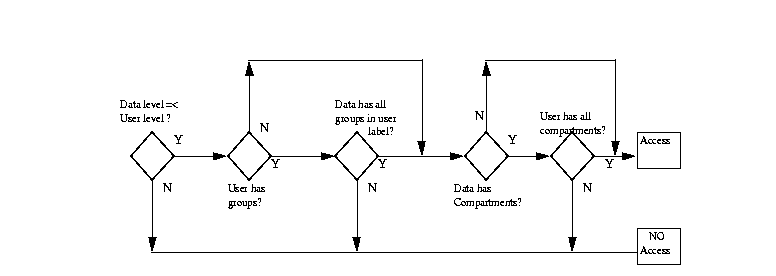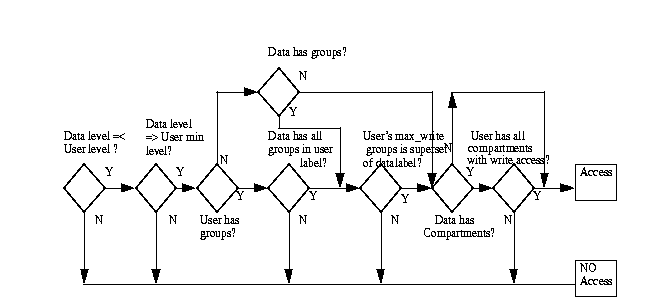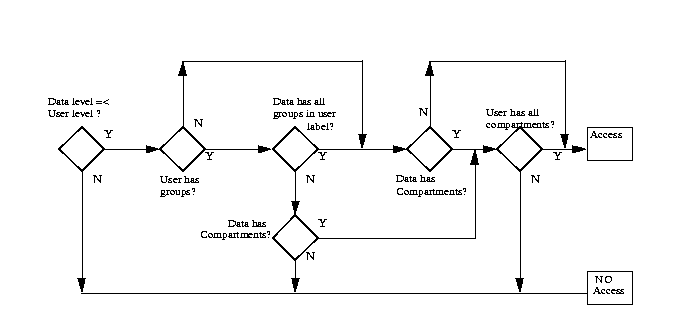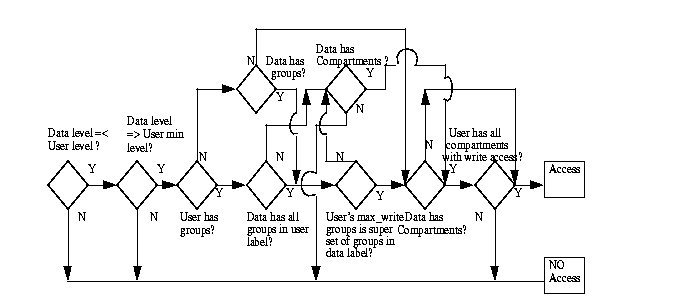Release 2 (9.2)
Part Number A96578-01
Home |
Book List |
Contents |
Index |
 Master Index |
 Feedback |
| Oracle Label Security Administrator's Guide Release 2 (9.2) Part Number A96578-01 |
|
This chapter discusses the Oracle Label Security implementation of releasability using inverse groups. It contains the following sections:
Inverse groups indicate releasability of information: they are used to mark the dissemination of data. When you add an inverse group to a data label, the data becomes less classified. For example, a user with inverse groups UK, US cannot access data which only has inverse group UK. Adding US to that data makes it accessible to all users with the inverse groups UK, US.
When you assign releasabilities to a user, you mark the communication channel to the user. For data to flow across the communication channel, the data releasabilities must dominate the releasabilities assigned to the user. In other words, releasabilities assigned to a data record must contain all the releasabilities assigned to a user.
The advantage of releasabilities lies in their power to broadly disseminate information. Releasing data to the entire marketing organization becomes as simple as adding the Marketing releasability to the data record.
Groups in Oracle Label Security identify organizations which own or access data. Like standard groups, inverse groups control the dissemination of information. However, the behavior of inverse groups differs from Oracle Label Security standard group behavior. By default, all policies created in Oracle Label Security use the standard group behavior.
The term, "releasabilities" is sometimes used to refer to the behavior provided by inverse groups. When you include inverse groups in a data label, the effect is similar to assigning label compartment authorizations to a user. When Oracle Label Security evaluates whether a user can view a row of data assigned a label with inverse groups, it checks to see whether the data, not the user, has the appropriate group authorizations: does the data have all the inverse groups assigned to the user? With standard groups, by contrast, Oracle Label Security checks to see whether a user is authorized for at least one of the groups assigned to a row of data.
Consider a policy which contains 3 standard groups: Eastern, Western, and Southern. User1's label authorizations include the groups Eastern and Western. Assuming User1 has been assigned the appropriate level and compartment authorizations in the policy, then:
Table 13-1 shows all the rows which User1 can potentially access, given the type of group which is used in the policy.
Standard groups indicate ownership of information: thus all data pertaining to a certain department can have that department's group in the label. When you add a group to a data label, the data becomes more classified. For example, a user with no groups can access data which has no groups in its label. If you add the group US to the data label, the user can no longer access the data.
This section explains how inverse groups are implemented, and how they work. It contains these topics:
When creating an Oracle Label Security policy, the administrator can specify whether the policy can use inverse group functionality to implement releasability. To do this, he specifies INVERSE_GROUP as one of the default_options in the CREATE_POLICY statement.
The INVERSE_GROUP option can only be set at policy creation time. Once a policy is created, this option cannot be changed.
The INVERSE_GROUP option is thus policy-wide. It cannot be turned on or off when the policy is applied to a table or schema. If you attempt to do so, using the procedure APPLY_TABLE_POLICY or APPLY_SCHEMA_POLICY, then an error will be generated.
Whereas other policy enforcement options can be dropped from a policy, the INVERSE_GROUP policy configuration option cannot be dropped once it is set. To remove the option you must drop, and then re-create, the policy.
The administrator can give individual users authorization for one or more inverse groups.
When an Oracle Label Security policy is created with the inverse group option, the components in the policy label (levels, compartments, and groups) are the same as with standard groups. With inverse groups, however, the user's read groups and write groups have a different meaning and role in data access.
Consider the following policy example:
There are three levels:
|
UNCLASSIFIED |
UN |
|
CONFIDENTIAL |
CON |
|
SECRET |
SE |
One compartment:
|
FINANCIAL |
FIN |
Three groups:
|
EASTERN |
EAS |
|
WESTERN |
WES |
|
SOUTHERN |
SOU |
Two user labels have been assigned: CON:FIN and SE:FIN:EAS,WES
Two data labels have been assigned: CON:FIN:EAS and SE:FIN:EAS
User access to the data differs, depending on the type of group being used:
The user with the label CON: FIN cannot read CON:FIN:EAS data.
The user with the label SE:FIN:EAS,WES can read SE:FIN:EAS data.
The user with the label CON: FIN can read CON:FIN:EAS data.
The user with the label SE:FIN:EAS,WES cannot read SE:FIN:EAS data.
This section explains how inverse groups affect computed label values. It contains these topics:
After the administrator assigns label authorizations to a user, Oracle Label Security automatically computes a number of labels. With inverse groups these labels are as follows:
From the computed values in Table 13-2, two sets of groups are identified for label evaluation of read and write access:
As shown in Table 13-3, for standard groups you can have READ ONLY and READ/WRITE authorizations; for inverse groups you can have WRITE ONLY and READ/WRITE authorizations.
Although Max Read Groups identifies the set of groups contained in the Max Read Label, this value represents the minimum set of inverse groups that can be set. For example:
Max Read Groups: S:C1:G1,G2
Max Write Groups: S:C1:G1,G2,G3,G4,G5
Here, the user can read data which contains at least the 2 groups listed in Max Read Groups.
Note that in standard groups, there can never be a situation in which there are more groups in the Max Write Label than in the Max Read Label.
Standard groups in Oracle Label Security are hierarchical, such that a group can be associated with a parent group. For example, the EASTERN region can be the parent of two subordinate groups: EAS_SALES, and EAS_HR.
In a policy with standard groups, if the user label has the parent group, then it can access all data of the subordinate groups.
With inverse groups, parent-child relationships are not supported.
With inverse groups implemented, the meaning of user privileges remains the same.
When the user has no special privileges, then the read algorithm and the write algorithm are different for groups and inverse groups. The differences are described below, in "Algorithm for Read Access with Inverse Groups" and "Algorithm for Write Access with Inverse Groups".
The effect of inverse groups on the COMPACCESS privilege is described below, in "Algorithms for COMPACCESS Privilege with Inverse Groups".
Inverse groups have no impact upon the following user privileges:
This section describes the algorithm for read access with inverse groups.
To read data in a table with the INVERSE GROUP option in effect, the label evaluation process proceeds from levels to groups to compartments, as illustrated in Figure 13-1. (Note that the current session label is the label being evaluated.)
If the user's label passes these tests, then he can access the data. If not, he is denied access. Note that if the data label is null or invalid, then the user is denied access.

Text description of the illustration releasa.gif
This section describes the algorithm for write access with inverse groups.
To write data in a table with the INVERSE GROUP option, the label evaluation process proceeds from levels to groups to compartments, as illustrated in Figure 13-2. (Note that the current session label is the label being evaluated.)
The groups in the data label must be a superset of the groups in the user label.
or
The user has READ access privilege on the policy.
Note that if the data label is null or invalid, then the user is denied access.

Text description of the illustration releas2.gif
This section describes the algorithms for read and write access with inverse groups, for users who have COMPACCESS privilege.
The COMPACCESS privilege allows a user to access data based on the row's compartments, independent of the row's groups.
Figure 13-3 and Figure 13-4 show the label evaluation process for read access and write access for a user with COMPACCESS privilege. If the data label is null or invalid, then the user is denied access.
(Note that the current session label is the label being evaluated.)

Text description of the illustration releas3.gif

Text description of the illustration releas4.gif
This section describes how inverse groups affect session labels and and row labels.
The use of inverse groups affects the behavior of Oracle Label Security procedures which determine the session label. The SA_USER_ADMIN.SET_DEFAULT_LABEL and SA_USER_ADMIN.SET_ROW_LABEL procedures set the user's initial session label and row label, respectively, to the one specified.
A user's default session label can be changed using SA_USER_ADMIN.SET_DEFAULT_LABEL. In the case of standard groups, the default session label can be set to include any groups in the authorized list, as long as the current default row label will still be dominated by the new write label. That is, the row label will have the same or fewer standard groups than the new write label.
The same rule applies for SA_USER_ADMIN.SET_ROW_LABEL.
In the case of inverse groups, the default session label can be set to include any groups in the authorized list, as long as the current default row label will still be dominated by the new write label. That is, the row label will have the same or more inverse groups than the new write label.
The same rule applies for SA_USER_ADMIN.SET_ROW_LABEL.
| See Also: |
The use of inverse groups affects the behavior of the SA_SESSION.SET_LABEL and SA_SESSION.SET_ROW_LABEL procedures, which can be used to set the user's current session label and row label, respectively.
With standard groups, the SA_SESSION.SET_LABEL procedure can be used to set the session label to include any groups in the user's authorized group list. (Subgroups of authorized groups are implicitly included in the authorized list.) Note that if you change the session label, this may affect the value of the session's row label.
Use the SET_ROW_LABEL procedure to set the row label value for the current database session. The compartments and groups in the label must be a subset of compartments and groups in the session label to which the user has write access.
With inverse groups, the addition of groups to the session label decreases a user's ability to access sensitive data with fewer groups. The removal of groups enables him to access more sensitive information. The user should thus be allowed to add groups to the session label, as long as Max Read Groups is a subset of the groups in the session label, and Max Write Groups is a superset of groups in the session label. The same restriction applies when a user removes groups from his session label.
Note that there are no subgroups of authorized groups when using inverse groups. This is because parent groups are not allowed in policies using inverse groups.
Use the SET_ROW_LABEL procedure to set the row label value for the current database session. The compartments in the label must be a subset of compartments in the session label to which the user has write access.
The user is allowed to add inverse groups to the row label, as long as the session label inverse groups are a subset of the row label inverse groups, and Max Write Groups is a superset of inverse groups in the row label.
For example:
This section presents examples to illustrate the use of inverse groups.
Consider a User1, of a policy that implements inverse groups. The user has the following labels:
|
Max Read Label |
SE:ALPHA,BETA:G1,G2 |
|
Max Write Label |
SE:ALPHA:G1,G2,G3 |
|
Default Read Label |
SE:ALPHA,BETA:G1,G2 |
|
Default Write Label |
SE:ALPHA:G1,G2 |
|
Default Row Label |
SE:ALPHA:G1,G2 |
These values are derived from the foregoing labels:
|
Max Read Groups |
G1,G2 |
|
Max Write Groups |
G1,G2,G3 |
The following conclusions can be drawn:
If standard groups were being used, rather than inverse groups, then User1 could update data with label SE:ALPHA:G1.
Consider a User1, of a policy that implements inverse groups. The user has the following labels:
|
Max Read Label |
C:ALPHA: |
|
Max Write Label |
C:ALPHA:G1,G2,G3 |
|
Default Read Label |
C:ALPHA: |
|
Default Write Label |
C:ALPHA: |
|
Default Row Label |
C:ALPHA: |
These values are derived from the foregoing labels:
|
Max Read Groups |
(an empty set) |
|
Max Write Groups |
G1,G2,G3 |
The following conclusions can be drawn:
This is true because the row label must have at least the groups in the session label, and can at most have the Maximum Write Groups. If the session label is G1, then you can set the groups in the row label from G1 to the Max Write Groups (G1,G2,G3).
When the INVERSE_GROUP option is specified at the time the policy is created, a change occurs in the algorithms which determine the read and write access of the user to labeled data. This section describes how inverse groups affect the behavior of the following procedures:
The CREATE_POLICY procedure under the SYSDBA package creates the policy, defines an optional policy-specific column name, and specifies a set of default policy options. With inverse group support the user has one more policy enforcement option, INVERSE_GROUP. For example:
PROCEDURE CREATE_POLICY ( HR IN VARCHAR2, SA_LABEL IN VARCHAR2 DEFAULT NULL,
INVERSE_GROUP IN VARCHAR2 DEFAULT NULL);
The ALTER_POLICY procedure under the SYSDBA package enables you to change a policy's default enforcement options, except for the INVERSE_GROUP option. Once a policy is configured for inverse groups, it cannot be changed.
The ADD_GROUPS procedure adds groups to a user, indicating whether the groups are authorized for write as well as read.
The access_mode is one of two variables which specify the type of access authorized.
Note that if in_def is Y in a row, then in_row must also be set to Y, but not vice versa.
If the access mode is set to READ_WRITE, the group is added to Max Read Groups, and Max Write Groups. If the group should be added only to the Max Write Groups, then the access mode should be set to SA_UTL.WRITE_ONLY. If not specified, access_mode is set to SA_UTL.READ_WRITE. If in_def is not specfied, then it will be set to Y or N depending on whether the access mode is READ_WRITE or WRITE_ONLY, respectively. The same is the case with the in_row field.
The ALTER_GROUPS procedure changes the write access, the default label indicator, and/or the row label indicator for each of the groups in the list.
The behavior of inverse groups is the same as described in the case of ADD_GROUPS.
The SET_GROUPS procedure assigns groups to a user and identifies default values for the user's session label and row label. Inverse groups are handled differently from standard groups, as follows:
The SET_USER_LABELS procedure sets the user's levels, compartments, and groups using a set of labels, instead of the individual components. Inverse groups are handled differently from standard groups, as follows:
The SET_DEFAULT_LABEL procedure sets the user's initial session label to the one specified.
All the rules mentioned for setting inverse groups component of session label mentioned in "Session Labels and Inverse Groups" are applicable here.
Use the SET_ROW_LABEL procedure to set the user's initial row label to the one specified.
When specifying the row_label, the inverse groups component must contain at least all the inverse groups in def_label and should be a subset of Max Write Groups.
Use the CREATE_GROUP procedure to create a group and specify its short name and long name, and optionally a parent group.
With inverse groups the parent_name field should always be NULL. If the user specifies a value for this field, then an error message is displayed, indicating that the group hierarchy is disabled.
This function is disabled for policies with the inverse group option. An error message is displayed if the user invokes this function.
Use the SET_LABEL procedure to set the label of the current database session.
For the current user, this procedure follows the same rules for setting the session label as does the sa_user_admin.set_user_label function.
Use the SET_ROW_LABEL procedure to set the default row label value for the current database session.
For the current user, this procedure follows the same rules for setting the row label as does the sa_user_admin.set_row_label function.
The LEAST_UBOUND (LUBD) function returns a character string label that is the least upper bound of label1 and label2: that is, the one label which dominates both.
With standard groups, the least upper bound is the highest level, the union of the compartments in the labels, and the union of the groups in the labels.
With inverse groups, the least upper bound is the highest level, the union of the compartments in the labels, and the intersection of the inverse groups in the labels.
For example, with inverse groups the least upper bound of HIGHLY_SENSITIVE:ALPHA:G1,G2 and SENSITIVE:BETA:G1 is HIGHLY_SENSITIVE:ALPHA,BETA:G1
The GREATEST_LBOUND (GLBD) function can be used to determine the lowest label of the data that can be involved in an operation, given two different labels. It returns a character string label that is the greatest lower bound of label1 and label2.
With standard groups, the greatest lower bound is the lowest level, and the intersection of the compartments in the labels and the groups in the labels.
With inverse groups, the greatest lower bound is the lowest level, and the intersection of the compartments in the labels and the union of inverse groups in the labels.
For example, with inverse groups the greatest lower bound of HIGHLY_SENSITIVE:ALPHA:G1,G3 and SENSITIVE::G1 is SENSITIVE:G1,G3
Dominance rules for Oracle Label Security with standard groups can be summarized as follows:
A user label dominates a data label if:
Dominance rules for Oracle Label Security with inverse groups can be summarized as follows:
A user label dominates a data label if:
|
 Copyright © 2000, 2002 Oracle Corporation. All Rights Reserved. |
|